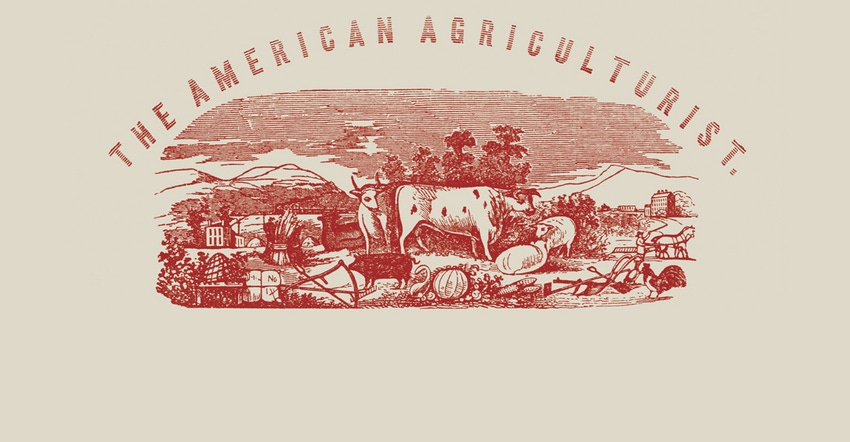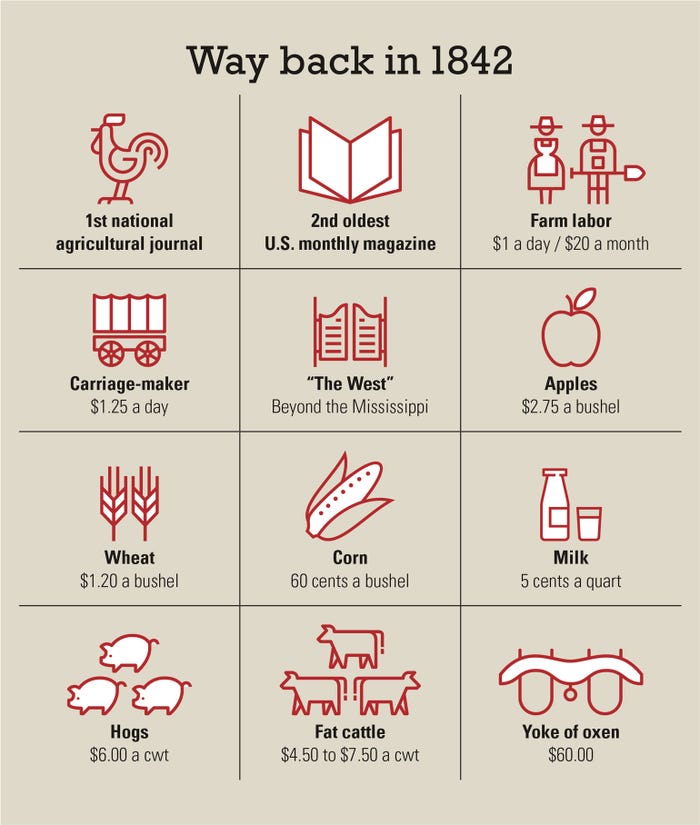
Times and technology continually change. Just as today, agriculture’s best and brightest minds 175 years ago envisioned America’s great potentials. With those visions, American Agriculturist began printing in April 1842, selling for “one dollar per annum, payable in advance.” Today, it’s the nation’s second-oldest monthly publication.
Farmers and those dreaming of farming scoured through that first issue’s tiny print for ideas to increase their prosperity. Its one small livestock ad read: “Berkshire Pigs: out of late importation … delivered in New York City at $25 to $50 per pair or on steamboats at Buffalo, N.Y., at $20 to $40 per pair, two to four months old.”
Way out West
Most fascinating was that first issue account of the unbroken, unfenced prairies in the West. “When we emerged from the wood, for miles around stretched forth one broad expanse of clear open land — an indescribable delightful feeling,” wrote Solon Robinson. “No plough or spade has broken the sod of ages.”
In wonder, he awed at the potential of ploughing prairie grasses deeply rooted in black soil. “You who have ploughed so many acres of green sward with old ‘Duke and Darby’ would fancy a breaking team of four, five or even six yoke of oxen cutting a furrow of 16 to 24 inches wide with wrought iron and steel.”
Then he added: “I do believe a smaller plough and less team would be better. The sod, though without sticks, stumps and stones, is more tough than can be believed. It requires a sharp plow, and such a team would plough one to two acres a day, about four inches deep — not near the bottom of the roots.”
Robinson acknowledged his difficulty in describing the prairie as “destitute of buildings, fences, any mark of civilization.” That was central Iowa circa 1840, then a sparsely settled Dakota Territory that became a state in 1846. “The most feasible plan,” Robinson envisioned, “would be to enclose large tracts by ditching, and cultivate the land without division fences.” Robinson lived in an Iowa prairie village of Lake City, just a few miles south of where this writer’s grandfather farmed. That’s exactly what those lands came to be.
Remember, John Deere invented his steel moldboard plow just five years earlier. The first gas-powered tractor wasn’t invented until 50 years later.

Print ads in those early issues were scant and just that — typewritten with no pictures. So, advertising and market news were still in their infancies. Much of the news during those early years were long personal letters of college-educated men who traveled widely, even to Europe, in search of better ways of improving crop and livestock thriftiness, dabbling in politics along the way.
Productivity unleashed
Fueled in part by the 1849 California Gold Rush, farmers quickly spread westward to cultivate those prairies. By the 1890s, American Agriculturist had become the first national farm publication with five regional editions stretching from New York to San Francisco — still selling for one dollar per annum. Wheat, the largest commodity crop, was already being exported. Hemp was legally grown for fiber and seed. Eastern farmers were forming organizations to collectively market produce, field crops and livestock.
Overproduction was already an issue: One editorial noted: “Prices of farm lands and produce cannot go lower. If an honest effort were made to probe the matter to the bottom, it would doubtless be proven that overproduction is today the great bane of American farming.”
Over the past 175 years, American Agriculturist has been guided by editors and publishers who were farmers, educators, county agents, journalists and even politicians. Henry Morgenthau Jr., having all those skills, purchased the magazine in 1922 and split his time between the New York City office and his Fishkill Farms, an apple and dairy farm at Hopewell Junction, N.Y. He eventually became U.S. Treasury Secretary under Franklin Delano Roosevelt.
Today’s Fishkill Farms is operated by grandson Josh Morgenthau. See related story on page 10.
About the Author(s)
You May Also Like




